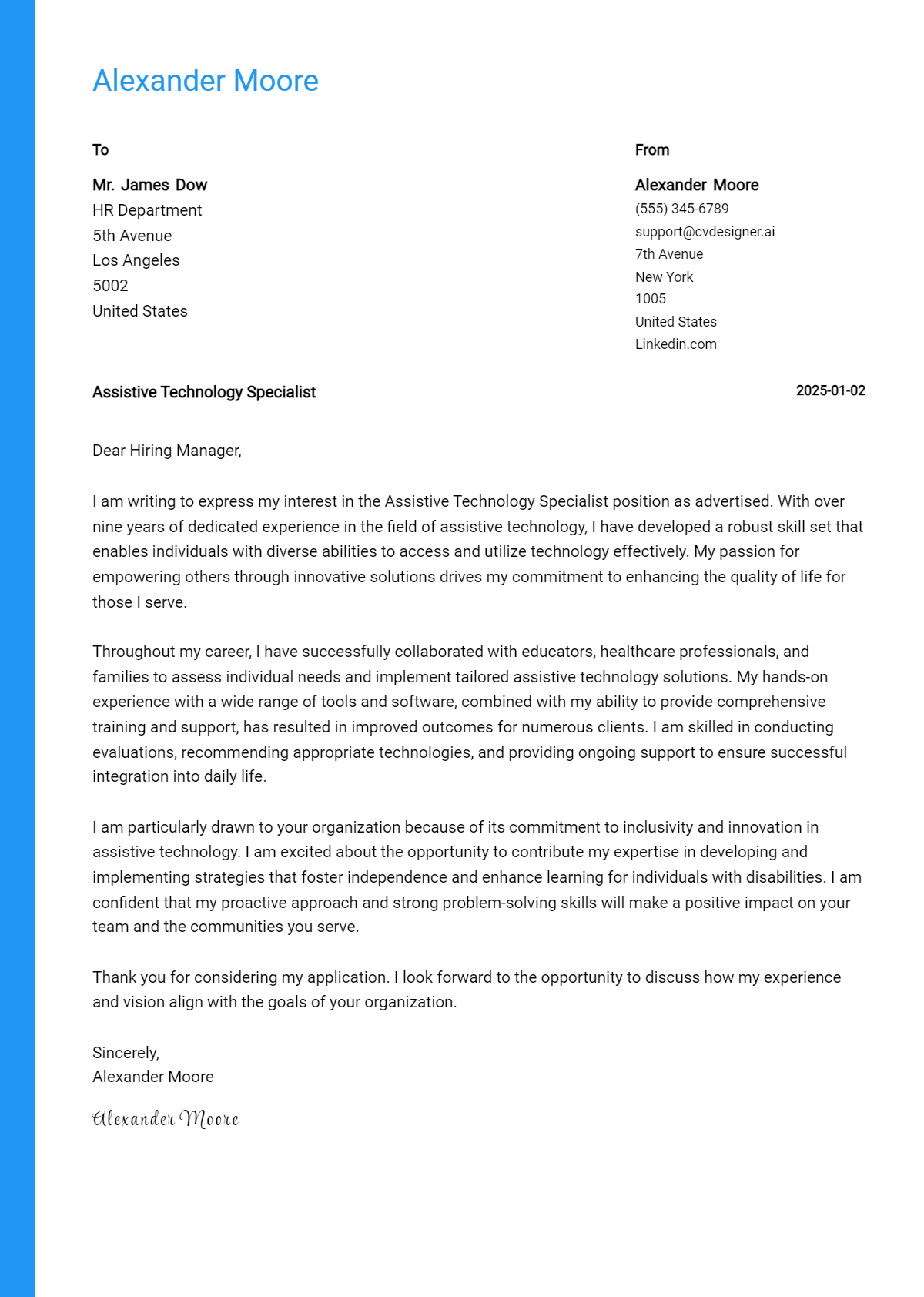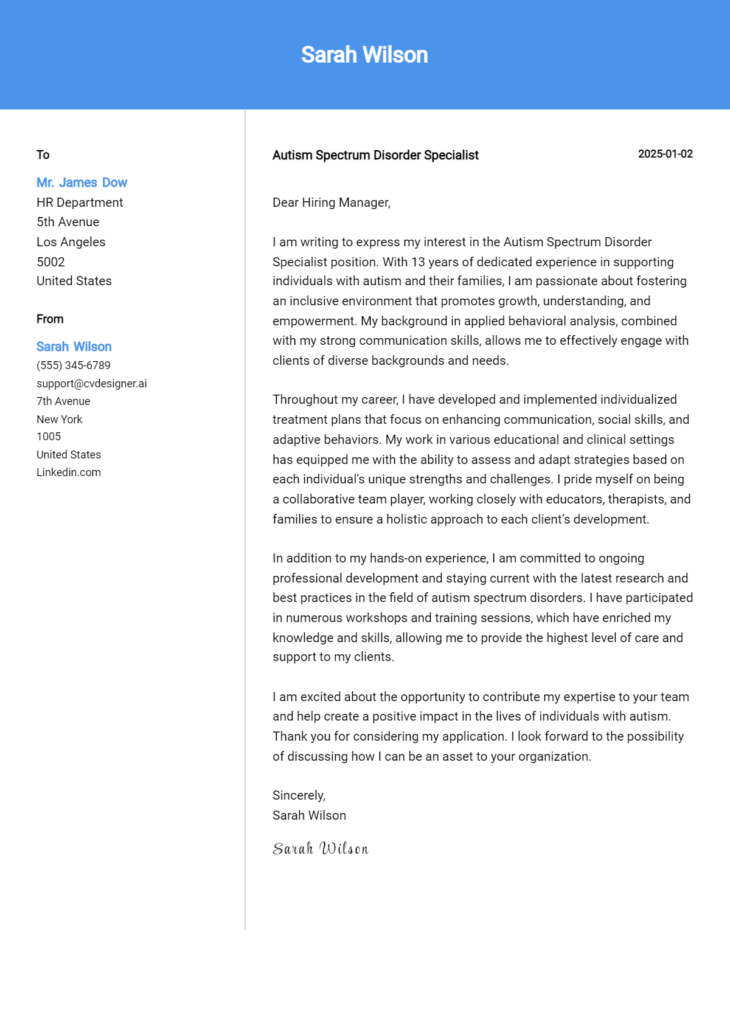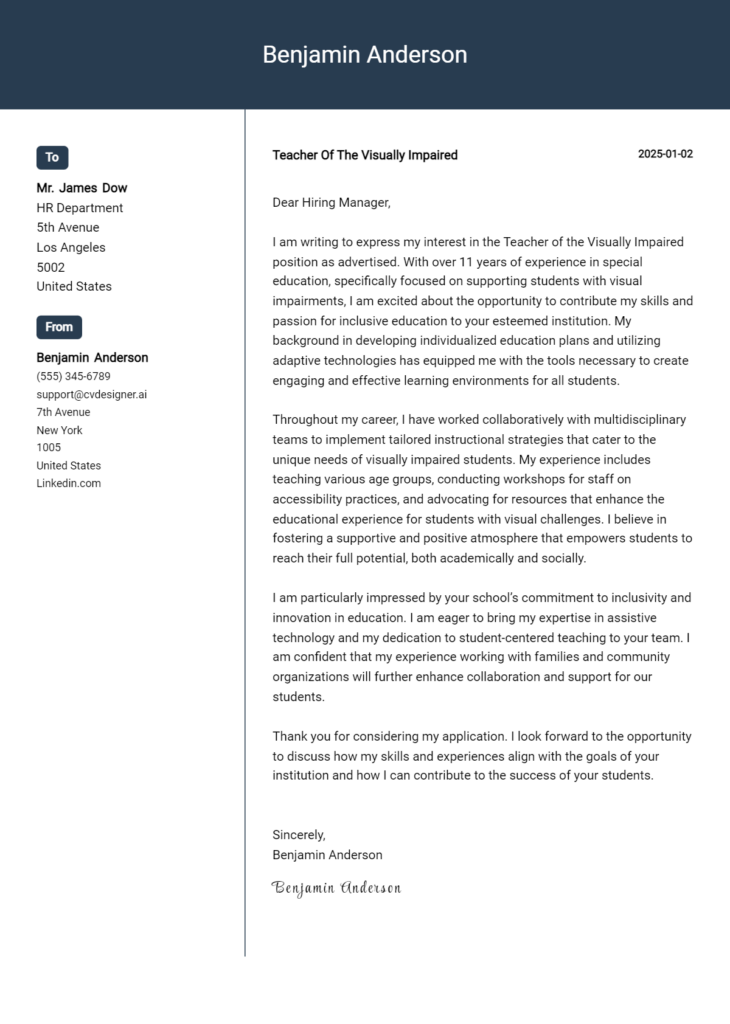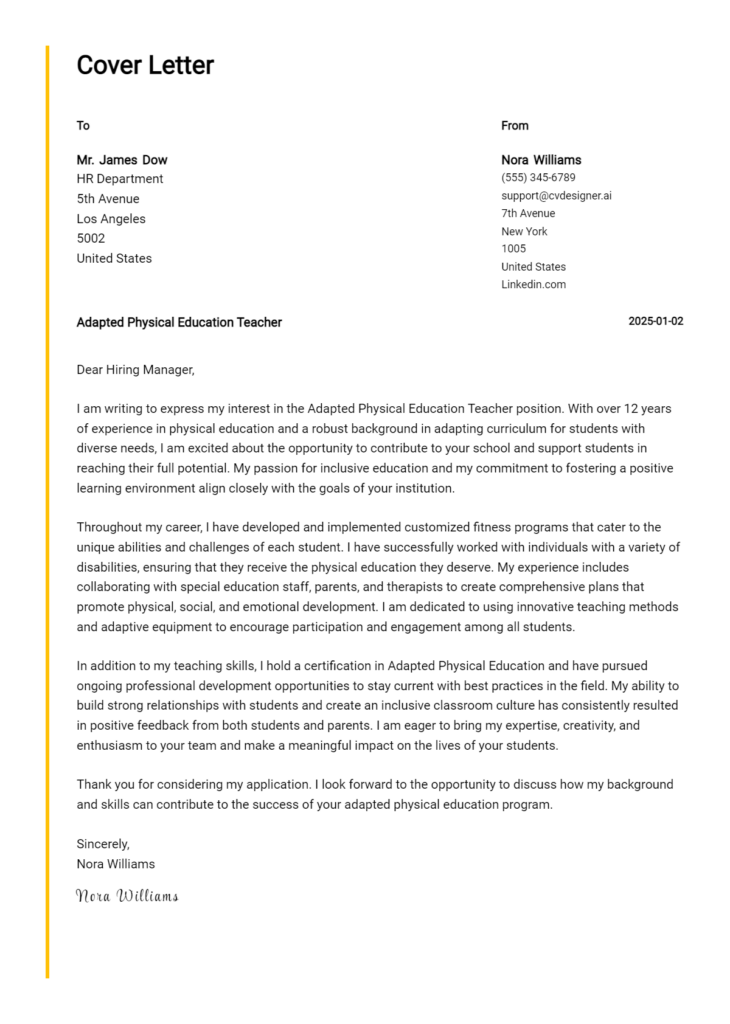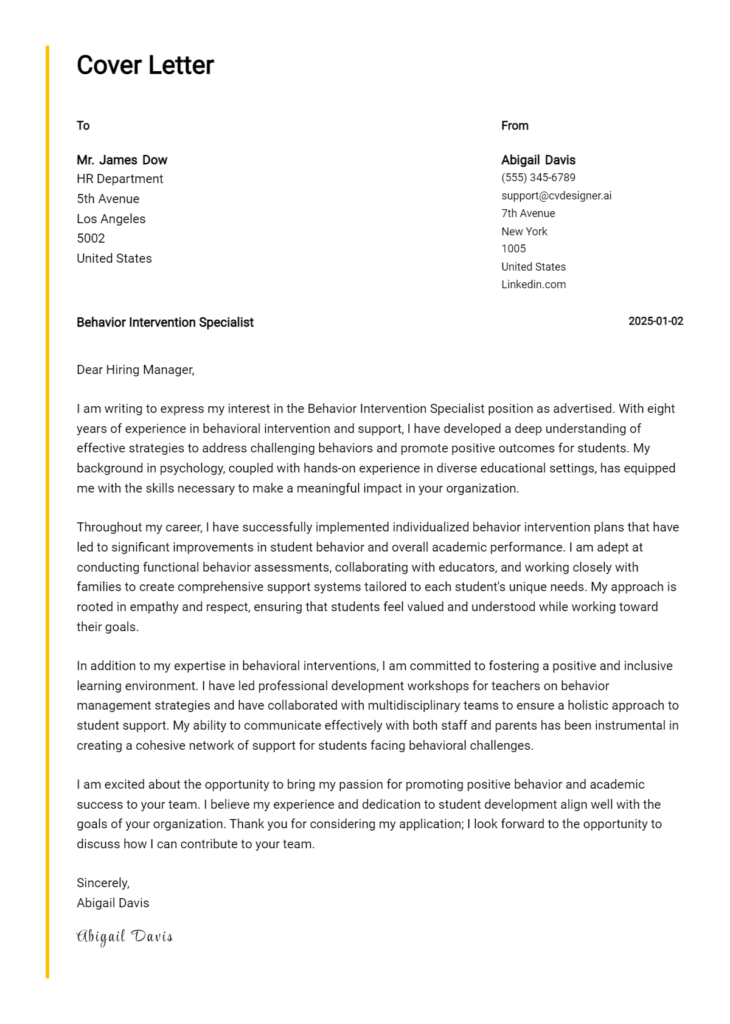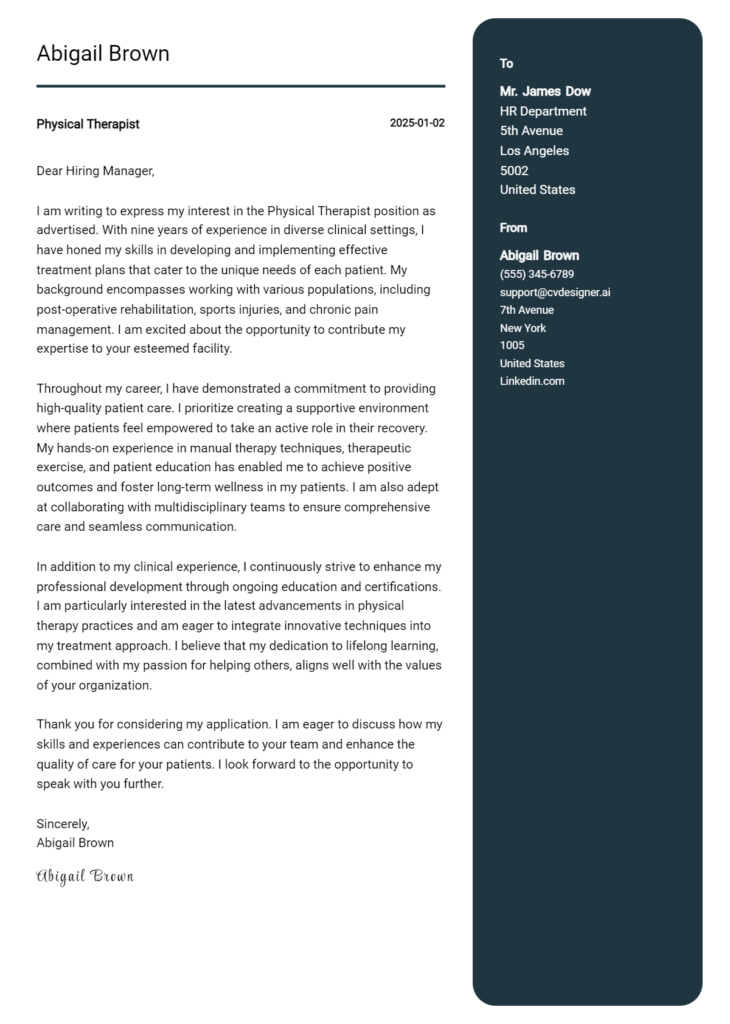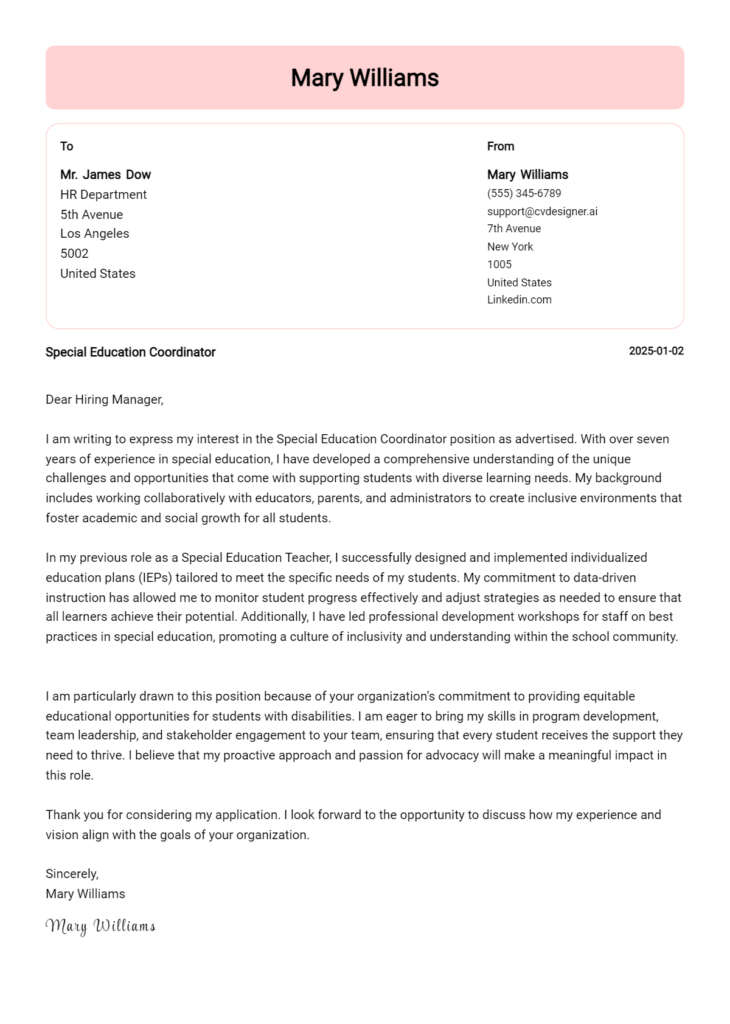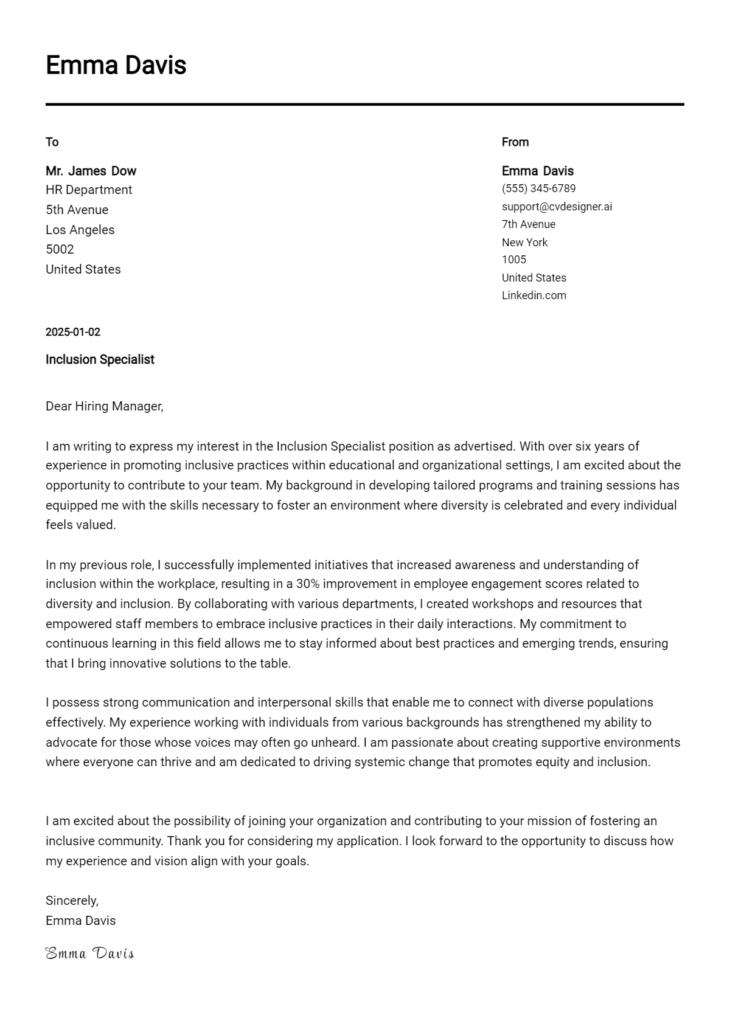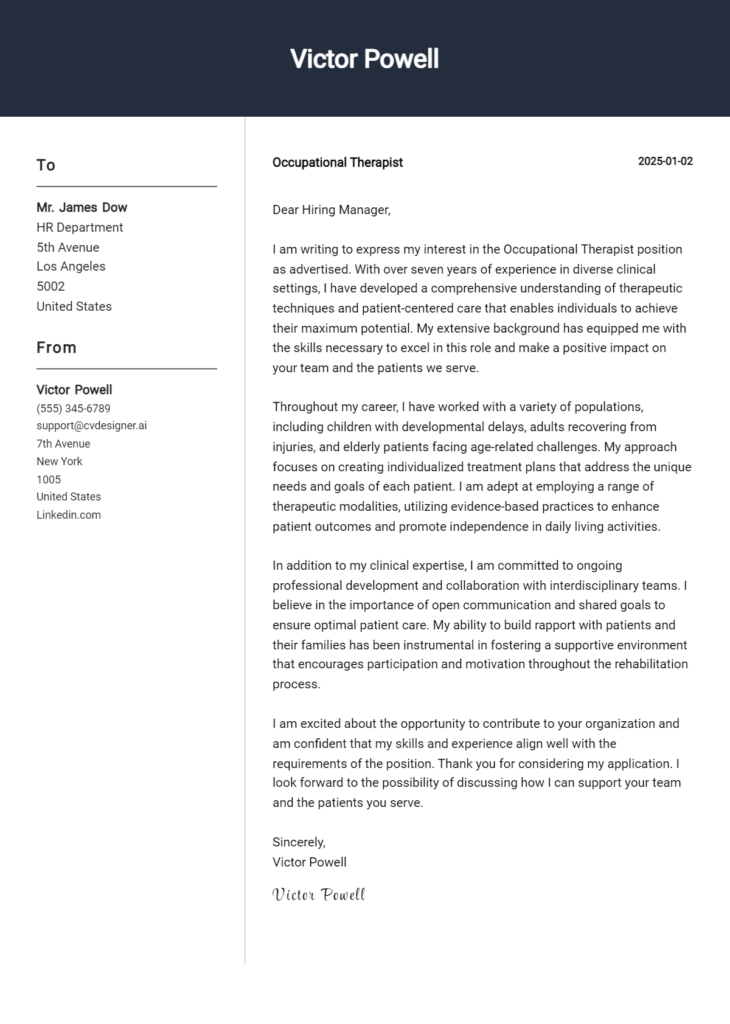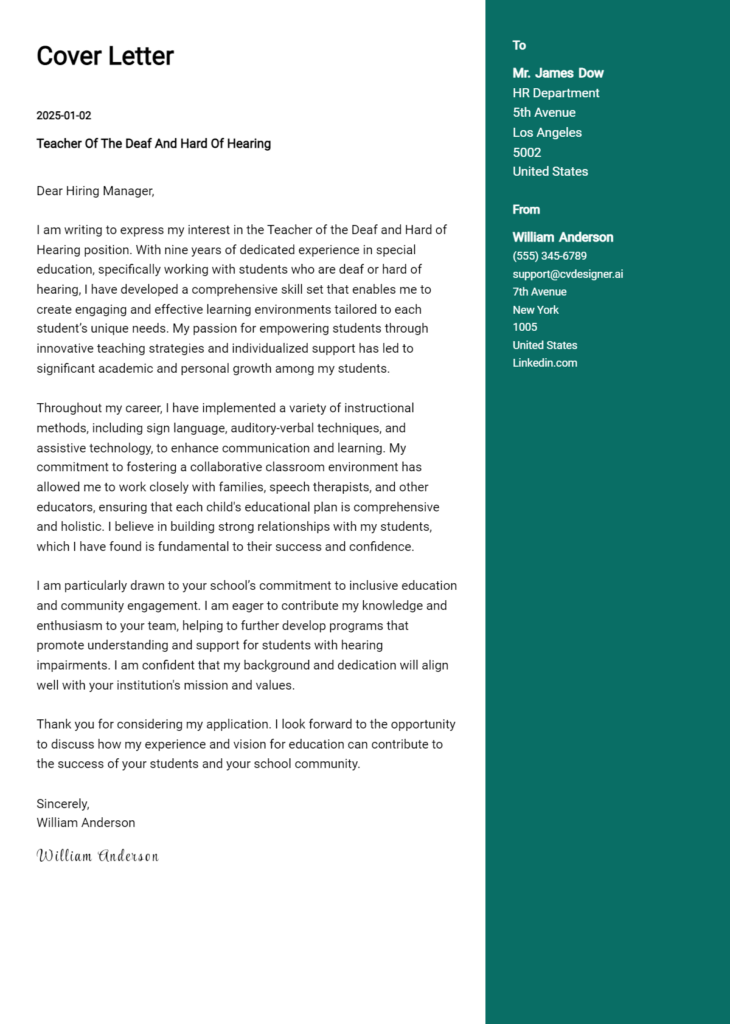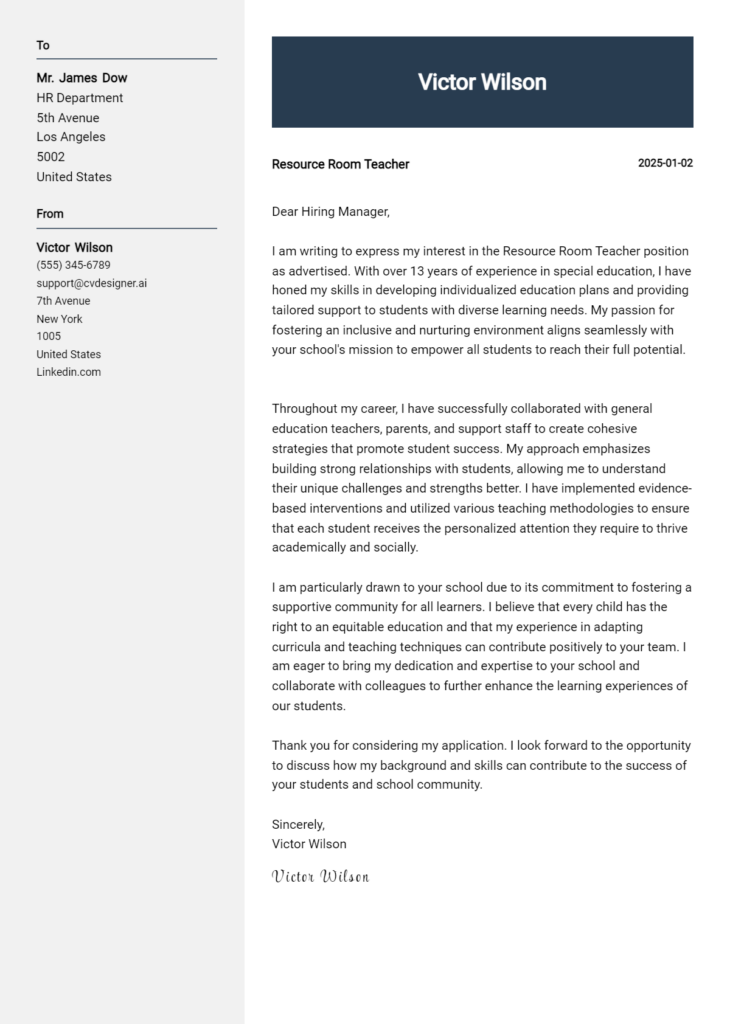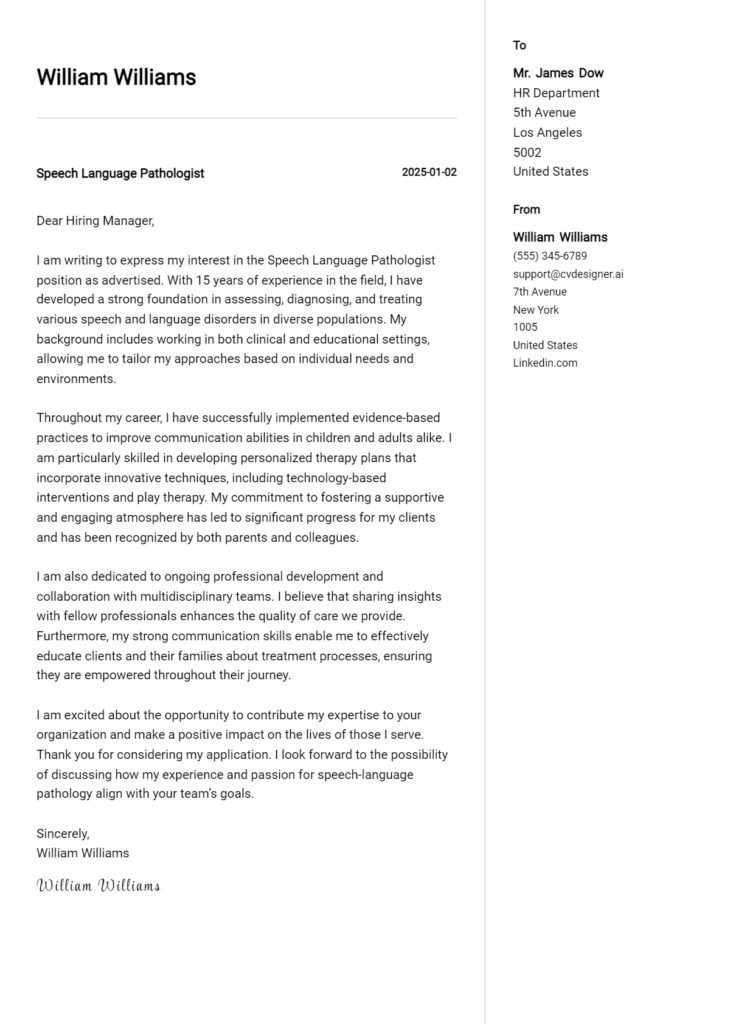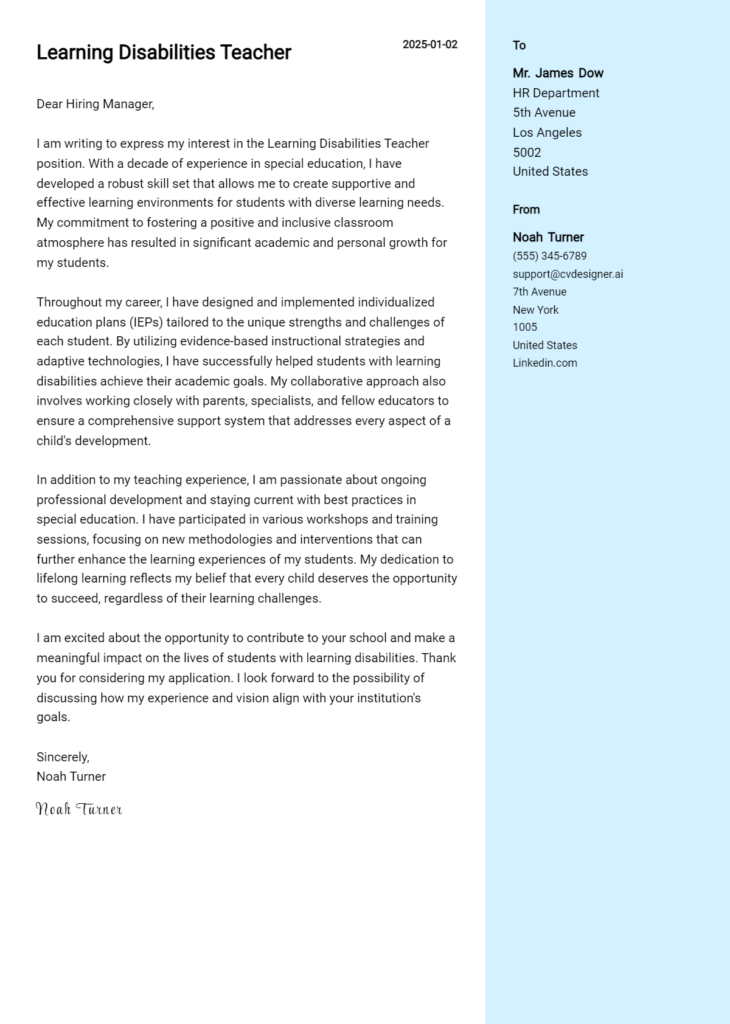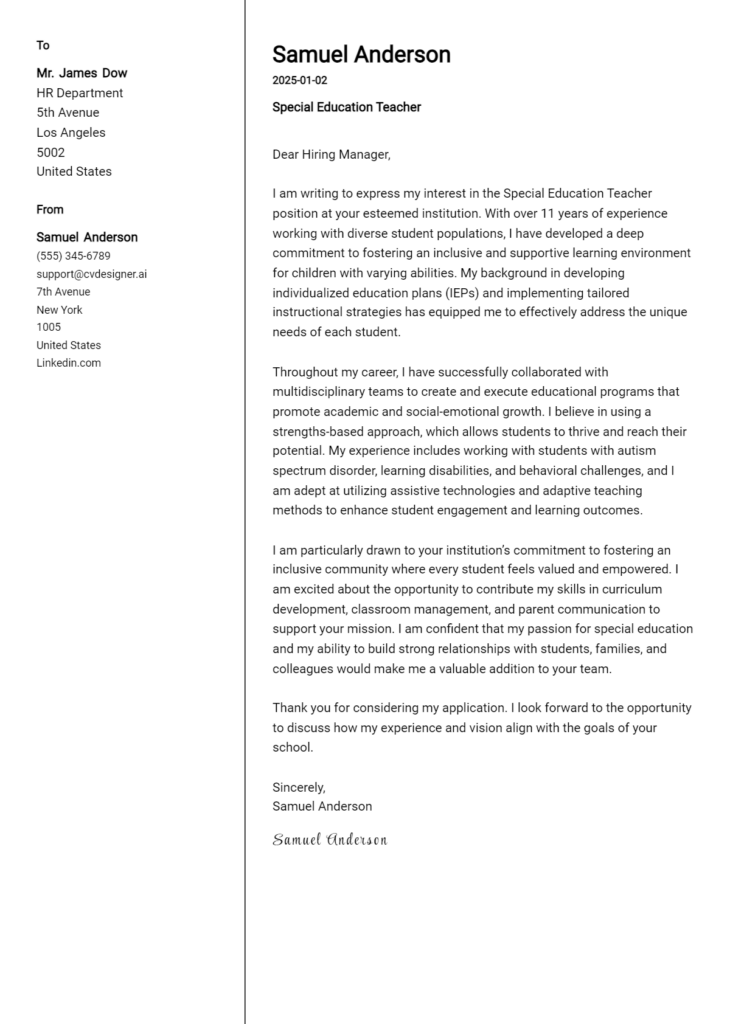Assistive Technology Specialist Cover Letter Examples
Explore additional Assistive Technology Specialist cover letter samples and guides and see what works for your level of experience or role.
How to Format an Assistive Technology Specialist Cover Letter?
Crafting a well-structured cover letter is essential for an Assistive Technology Specialist, as it not only showcases your relevant skills and experience but also demonstrates your commitment to accessibility and support for individuals with disabilities. Proper formatting reflects your professionalism and attention to detail, which are critical in this role where technology must be tailored to meet diverse needs. By effectively organizing your cover letter, you can capture the hiring manager's attention and convey your passion for enhancing the lives of others through assistive technology.
In this guide, we'll explore how to structure your cover letter, providing specific insights and examples relevant to the Assistive Technology Specialist field.
We'll focus on the essential components of a professional cover letter, including:
- Cover Letter Header
- Cover Letter Greeting
- Cover Letter Introduction
- Cover Letter Body
- Cover Letter Closing
Each section is vital in presenting your qualifications and dedication to the field. Let’s break down each part to help your cover letter shine.
Importance of the Cover Letter Header for an Assistive Technology Specialist
The cover letter header is a critical component of your application as an Assistive Technology Specialist. It serves as the first impression to potential employers and sets the tone for the rest of your correspondence. A well-structured header not only provides essential contact information but also demonstrates your professionalism and attention to detail. The header should include your name, address, phone number, email, the date, and the recipient's name and address. Clarity is key; a clean, organized header makes it easy for hiring managers to identify you and your qualifications quickly.
Here are examples of a strong and weak cover letter header for an Assistive Technology Specialist:
Strong Example
John Doe 123 Assistive Lane Tech City, ST 12345 (123) 456-7890 johndoe@email.com October 1, 2023 Jane Smith Hiring Manager Innovative Tech Solutions 456 Technology Blvd Tech City, ST 12345
Weak Example
John 123 Lane Tech City 10/1/23 To Whom It May Concern
In the strong example, the header is complete and clearly formatted, while the weak example lacks critical details, making it less professional and harder to read.
The Importance of the Cover Letter Greeting
The greeting of your cover letter is crucial as it sets the tone for the entire document. A well-crafted greeting not only conveys professionalism but also showcases your attention to detail and genuine interest in the position. By directly addressing the hiring manager, you create a sense of personalization that can differentiate you from other candidates. To avoid sounding generic, it’s beneficial to research the hiring manager’s name or title; this level of effort reflects your enthusiasm for the role. A tailored greeting can create an immediate connection, while a vague or impersonal one may suggest a lack of effort.
Strong Greeting Example
Dear Ms. Johnson,
Weak Greeting Example
To Whom It May Concern,
The Importance of a Strong Cover Letter Introduction for an Assistive Technology Specialist
A well-crafted cover letter introduction is crucial for an Assistive Technology Specialist as it sets the tone for the entire application. The introduction should not only capture the hiring manager's attention but also express the candidate's genuine interest in the role. Furthermore, it should briefly showcase key skills or achievements that are relevant to the position. A strong introduction can distinguish a candidate from others, while a weak one can lead to a missed opportunity. Below are examples that illustrate the difference between a compelling and a lackluster introduction.
Strong Example
Dear [Hiring Manager's Name], I am excited to apply for the Assistive Technology Specialist position at [Company Name], where I can leverage my passion for enhancing accessibility and my five years of experience in assistive technology solutions. Having successfully implemented adaptive technologies for diverse populations, including individuals with disabilities, I am eager to contribute my expertise in creating inclusive environments that empower users to achieve their full potential.
Weak Example
Dear [Hiring Manager's Name], I am writing to apply for the Assistive Technology Specialist job. I have some experience with technology, and I think I would be a good fit for the role. I hope you consider my application.
Purpose of the Cover Letter Body for an Assistive Technology Specialist
The body of a cover letter for an Assistive Technology Specialist serves as a vital platform for candidates to articulate their relevant skills, experiences, and the unique value they can bring to the organization. This section should highlight specific projects or accomplishments that demonstrate the applicant's expertise in assessing individual needs, implementing technology solutions, and enhancing accessibility. A well-crafted cover letter body not only conveys the candidate's passion for assistive technology but also establishes their credibility and readiness to contribute effectively to the team.
Strong Example
Dear Hiring Manager, I am excited to apply for the Assistive Technology Specialist position at XYZ Organization. In my previous role at ABC Center, I successfully implemented a comprehensive assistive technology program that increased student engagement by 40%. I collaborated with educators to assess individual needs, leading to the adoption of tailored solutions such as speech-to-text software and interactive learning tools. Additionally, I spearheaded a workshop series that trained over 50 staff members on the effective use of assistive technologies, fostering a culture of inclusivity and support. My commitment to empowering individuals through technology aligns perfectly with XYZ Organization's mission, and I am eager to contribute my skills to your team. Sincerely, [Your Name]
Weak Example
Dear Hiring Manager, I would like to apply for the Assistive Technology Specialist position. I have worked in technology and have helped some people with disabilities. I think it’s important to make sure everyone can use technology. I am familiar with some software and devices but haven’t done any specific projects that stand out. I am hoping to learn more about assistive technology. Thank you, [Your Name]
Importance of the Cover Letter Closing for an Assistive Technology Specialist
The closing of a cover letter is crucial for leaving a lasting impression on potential employers, particularly for an Assistive Technology Specialist position. It serves as a final opportunity to summarize your qualifications, reiterate your enthusiasm for the role, and encourage the reader to take the next steps, such as reviewing your resume or scheduling an interview. A strong closing can reinforce your fit for the position and make you memorable, while a weak closing may leave the employer uncertain about your interest or qualifications.
Strong Example
Thank you for considering my application for the Assistive Technology Specialist position. With my extensive background in assistive technology solutions and my passion for enhancing accessibility for individuals with disabilities, I am excited about the opportunity to contribute to your team. I am confident that my skills in evaluating and implementing technology to meet diverse needs would be an asset to your organization. I look forward to the possibility of discussing my application further and am eager to schedule an interview at your convenience. Thank you once again for your time and consideration.
Weak Example
I hope you find my resume interesting. I think I would be okay for the Assistive Technology Specialist job. If you want to talk more, you can call me or email me. Thanks, I guess.
Crafting an effective cover letter for the role of Assistive Technology Specialist is crucial for making a strong first impression. This document serves as your opportunity to showcase not only your technical skills and problem-solving abilities but also your understanding of the Software Development Life Cycle (SDLC), your capacity for teamwork, and your passion for continuous learning. The following tips will guide you in highlighting these essential areas, ensuring your cover letter stands out to potential employers.
Tips for Writing a Cover Letter as an Assistive Technology Specialist
Highlight Your Technical Skills
Clearly outline your technical expertise related to assistive technologies, such as software proficiency, hardware knowledge, and experience with adaptive tools. Use specific examples to demonstrate how you’ve applied these skills in past roles. This will help the hiring manager understand your qualifications and suitability for the position.Demonstrate Problem-Solving Abilities
Share instances where you successfully identified and resolved challenges faced by users of assistive technology. Whether it was through customizing solutions or providing training, illustrate your analytical thinking and resourcefulness. Employers value candidates who can think critically and adapt solutions to meet individual needs.Showcase Your Knowledge of SDLC
Discuss your familiarity with the Software Development Life Cycle and how it applies to developing assistive technologies. Mention any experience you have in different phases of SDLC, such as requirements gathering, testing, or deployment. This demonstrates your understanding of the processes involved in creating effective technology solutions.Emphasize Teamwork and Collaboration
Describe your experience working in interdisciplinary teams, collaborating with educators, healthcare professionals, and users. Highlight how you contributed to group projects and shared knowledge to enhance the overall effectiveness of assistive technology implementations. This will illustrate your ability to work well with others and contribute to a positive team environment.Convey Your Passion for Continuous Learning
Share any professional development activities you’ve engaged in, such as certifications, workshops, or relevant courses. Discuss how your commitment to staying updated with emerging technologies and trends in assistive technology equips you to provide the best solutions for users. This shows prospective employers that you are proactive about your knowledge and skills.
By incorporating these tips into your cover letter, you’ll present yourself as a well-rounded candidate who is not only qualified but also genuinely passionate about making a difference in the field of assistive technology. For more personalized support, consider using cover letter templates or a cover letter builder to help streamline your writing process.
Common Mistakes to Avoid in a Assistive Technology Specialist Cover Letter
Avoiding common mistakes in your cover letter is crucial for making a strong impression as an Assistive Technology Specialist. A well-crafted cover letter can set you apart from other candidates, but errors can undermine your efforts. Here are some common pitfalls to watch for:
Generic Content: Failing to customize your letter can make it seem impersonal. Always tailor your cover letter to the specific job and organization by highlighting relevant skills and experiences.
Lack of Specific Examples: Not providing concrete examples of your achievements can weaken your case. Use specific instances where you successfully implemented assistive technology solutions to demonstrate your impact.
Ignoring the Job Description: Overlooking key requirements in the job listing can lead to a mismatch. Carefully read the job description and ensure your cover letter addresses each of the listed qualifications.
Poor Formatting: A cluttered or unprofessional layout can detract from your message. Follow a clear cover letter format to keep your document organized and appealing.
Typos and Grammatical Errors: These mistakes can convey a lack of attention to detail. Always proofread your letter multiple times and consider using tools or asking someone else to review it.
Overly Lengthy Letters: Being too verbose can lose the reader's interest. Aim to keep your cover letter concise, ideally one page, focusing on the most relevant information.
Neglecting to Follow Up: Forgetting to express your enthusiasm for the position can leave a lack of engagement. Conclude your letter by reiterating your interest and suggesting a follow-up conversation.
By recognizing and addressing these common mistakes, you can create a compelling cover letter that stands out in the competitive field of assistive technology. For further inspiration, check out these cover letter examples.
Cover Letter FAQs for Assistive Technology Specialist
What should I include in my cover letter as an Assistive Technology Specialist?
In your cover letter, emphasize your technical skills, experience with assistive technologies, and your understanding of diverse user needs. Start with a strong introduction that captures your passion for the field. Highlight specific technologies or systems you have worked with, such as screen readers, communication devices, or adaptive software. Include examples of how you have successfully implemented these technologies to improve clients' lives. Don’t forget to mention your collaboration with educators, therapists, or other professionals, as teamwork is crucial in this role. Finally, express your enthusiasm for the position and how your goals align with the mission of the organization.
How can I tailor my cover letter for a specific Assistive Technology Specialist position?
To tailor your cover letter, carefully review the job description and identify key qualifications and skills the employer is seeking. Match your experiences and achievements with these requirements. Use specific language from the job posting to demonstrate alignment with the role. For instance, if the position emphasizes working with children with disabilities, discuss your relevant experience in that area. Research the organization to understand its culture and values, and incorporate this knowledge into your letter to show genuine interest. Mention any relevant certifications or training that sets you apart. Personalization will show the employer that you are well-prepared and genuinely interested in contributing to their team.
How should I format my cover letter for an Assistive Technology Specialist position?
Your cover letter should follow a professional format. Use a standard font like Arial or Times New Roman, with a size of 10-12 points. Start with your contact information at the top, followed by the date and the employer's contact information. Address the hiring manager by name, if possible, to personalize your letter. Maintain a clear structure with an introduction, body paragraphs, and a conclusion. Use short paragraphs for readability and bullet points if necessary to highlight key achievements. Keep the overall length to one page. Lastly, ensure there are no spelling or grammatical errors, as attention to detail is crucial in this role.
What common mistakes should I avoid in my cover letter for an Assistive Technology Specialist?
Common mistakes to avoid include generic language and failing to connect your skills to the specific job requirements. Ensure your cover letter is free of clichés and overly broad statements; be specific about your experiences and how they relate to the role. Avoid including irrelevant information that does not support your candidacy. Additionally, do not forget to proofread for spelling and grammatical errors, as these can undermine your professionalism. Lastly, refrain from discussing salary or benefits in your cover letter; focus instead on how your qualifications make you a strong fit for the position.
Build your Cover Letter in minutes
Use an AI-powered cover letter builder and have your letter done in 5 minutes. Just select your template and our software will guide you through the process.

